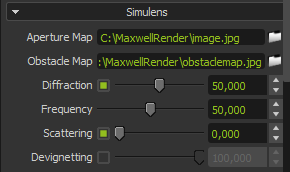SimuLens
Different SimuLens and Physical Sky settings
Maxwell Render SimuLens™ system allows the user to define a pattern to simulate the shape of the camera diaphragm that will model the pattern of light reaching the film, creating realistic lens diffraction effects (also known as glare). Diffraction happens when light goes through small holes, causing interference patterns. It is a very important phenomenon in optics, as it explains why for example a perfect telescope cannot be built. Light will always cause slight interference patterns because of the optical components used, causing the visual “artefact” known as diffraction/glare.
Furthermore, with the Simulens™ system, users can add a second pattern which defines 'obstacles' in the lens such as dust, water drops, fingerprints or eyelashes adding to a more realistic diffraction effect.
A second control was added to the lens diffraction feature, called Frequency, which lets you adjust the amount of colouring effect of the diffraction.
Another new parameter part of SimuLens™ is Lens Scattering, which simulates the scattering of light inside a lens system. This effect is typically called bloom.
These advanced controls bring a new level of quality and realism to computer graphics. Users can now have control over Diffraction, the frequency of Diffraction, and Lens Scattering to simulate bloom effects.
All these features are combined under the new SimuLens™ system which is also compatible with Multilight™.
The SimuLens adjusment panel

